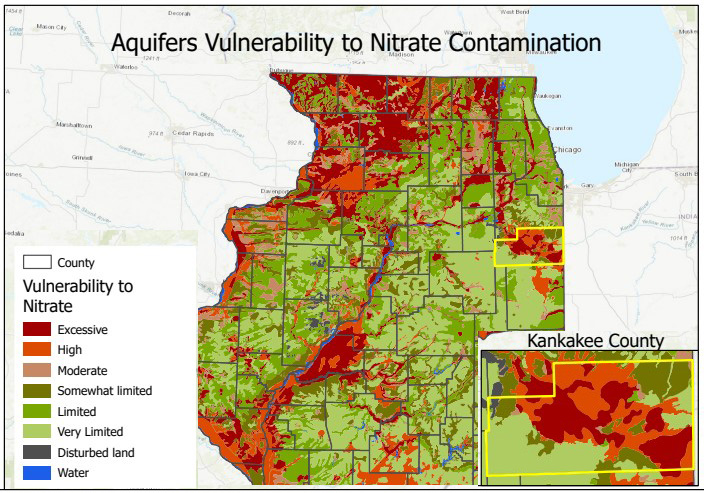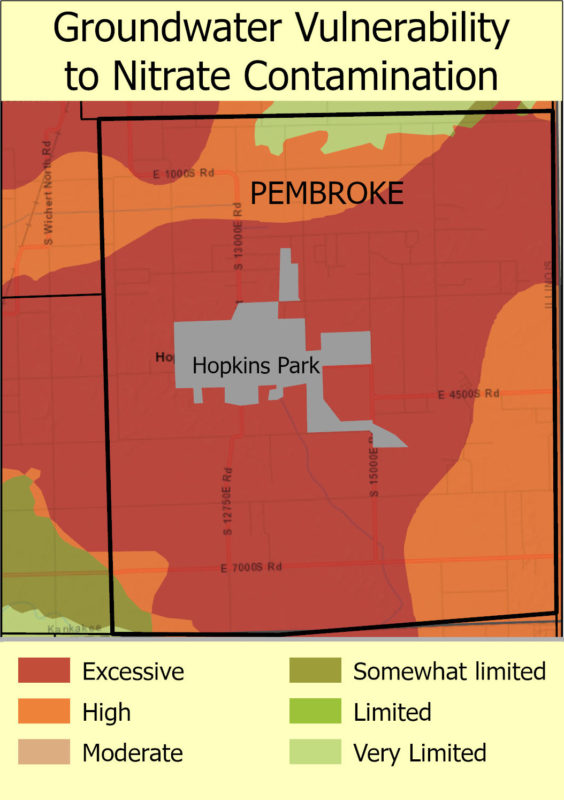Recently, PRN has partnered with the Community Development Corporation of Pembroke Township & Hopkins Park in Kankakee County to test local water quality in their area.

Pembroke has a rich history as one of the oldest black farming communities in the US. It also has aquifers identified as especially vulnerable to nitrate contamination. Runoff from farming, including nitrates, continues to be the top driver of water quality problems in Illinois.
On the Aquifer Vulnerability to Nitrate and Pesticides map, we can see much of Pembroke is dark red, or excessively vulnerable due to its sandy soils and the aquifer being close to the surface. In addition to being surrounded by agriculture, 70% of residents have shallow rural wells.
In partnership with the Community Dev. Corp, we developed a water testing and education program that provides residents with the tools to test the quality of drinking water coming out of their taps.
The Scope of Nitrate Contamination in Illinois
As we investigated the extent of nitrate contamination in Illinois drinking water, we discovered a lack of comprehensive data for shallow rural wells which are especially vulnerable.
Knowing the statewide extent of nitrate contamination and location of hot spots is essential because nitrate can cause acute diseases like blue baby syndrome in infants or, as recent research suggests, cancer with long term exposure. While existing reports show the average Illinois well had very low levels of nitrate, there were alarming hotspots with some of the highest levels in the nation. With incomplete data from around the state, it is impossible to know the extent of the problem.
As we work to better understand where Illinois groundwater may be more vulnerable to nitrate contamination, we identified certain features that increase the likelihood that wells will have elevated levels of nitrate. Those risk factors include 1) places where groundwater is close to the surface, 2) contains sandy soils, 3) is near agriculture, 4) wells are shallow (<50 ft), and 5) have dug and wide bore wells.
The only way to know if a well has high nitrate levels is to test the water since nitrate is tasteless and colorless. For the last two years, PRN has offered free well testing to learn more about where elevated nitrate levels exist. We are also doing outreach and education about the need for well owners to test their water.
Opportunities in Pembroke Township
Talking with the Community Dev. Corp has identified the challenges rural well owners in this community face. Some low income residents have wells that are only 15-30 feet deep, just enough to reach the groundwater. In many cases, getting a deeper well, getting a more modern drilled well, or connecting their water system to the local town of Hopkins Park is difficult and economically infeasible.

However, the same characteristics that make Pembroke’s groundwater vulnerable to contamination also creates an opportunity to make dramatic changes for the better. Shallow groundwater is quickly recharged and abundant. The close connection groundwater has with the surface means people will see the impact of improved land use and farming practices to their water quality sooner than deep groundwater, which if contaminated, may take decades to run clear even after conservation practices are implemented.
PRN is prioritizing drinking water quality in the broader context of the Nutrient Loss Reduction Strategy to ensure we make changes where needed most, therefore having the greatest impact.







